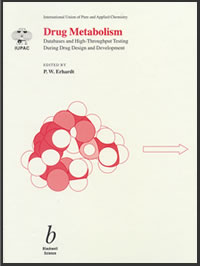Drug Metabolism
Databases and High-Throughput
Testing During Drug Design and Development
Erhardt,
P.W.
Blackwell Science, 1999 [ISBN 0-632-05342-9]

Given the exponential proliferation of technical data and our increasing
ability to rapidly disseminate it through a vast maze of electronic
networks, it is no wonder that new systems capable of managing and integrating
information are regarded among the most important of the emerging technologies
for future growth and economic development across the globe. And in
the midst of its own economics-driven revolution, this theme is probably
nowhere more relevant than within the pharmaceutical research and health-care
enterprise where new technologies having the potential to accelerate
drug discovery or to expedite the development of new drug candidates,
along with improved systems for enhancing the equitable delivery and
pharmacoeconomics of pharmaceutical care, would be immediately greeted
with considerable international enthusiasm.
It was into this climate that the International Union of Pure and Applied
Chemistry (IUPAC) chose to initiate a Working Party (WP) whose specific
mission would be to consider the topic 'Metabolism Databases and Their
Potential Utility in the Development of New Drugs.' This text represents
the product from the IUPAC sponsored WP's efforts as it has attempted
to address this topic during the course of the last year-and-a-half.
 Contents
ContentsIntroduction; Drug Metabolism Data: Past, Present and Future
Considerations;
Case Studies; Metabolism Considerations During the Discovery
and Development of Chlorpropamide, Pyrantel, Tetramisol and Certain
Alpha-adrenergic Agonists; Use of a Metabolism Database During the Development
of Zyflo; Prediction of Tebufelone Metabolism Using a Metabolism Database
Approach; Use of Metabolism Databases at Parke-Davis Pharmaceutical
Research, Inc.; A Perspective on the Use and Role of Metabolic Databases
at Pharmacia & Upjohn, Inc.; Use of a Metabolism Database at Eli Lilly
& Co.; Use of a Metabolism Database at Bayer A.G.; Construction of a
Metabolism Database Emphasizing Human CYP Data at Daiichi Pharmaceutical
Co., JP; A Prodrug and a Softdrug;
New Directions; High-Throughput Screening for Gastrointestinal
Absorption in the Generation of SAR Databases; Screening for the Effects
Cytochromes P450 on New Drugs and for the Influence of New Drugs on
the Cytochromes P450; Rationale For The Development Of Databases For
The Prediction Of Metabolic Drug Interactions: Experience With Antiepileptic
Drugs; High-Throughput Screening For Inhibition Of Cytochrome P450 Metabolism;
Three Dimensional Aspects of Metabolism in Human P450 Systems; The Use
of Microorganisms in the Study of Drug Metabolism; Metalloporphrins
As Synthetic Livers; Higher-Throughput In Vivo Pharmacokinetic Screening;
High-Throughput Screening In Preclinical Drug Metabolism: A Burgeoning
Trend; Statistics-Based Probabilities of Metabolic Possibilities; Use
of Metabolic Databases To Guide Target Selection For Anti-Microbial
Drug Design; Comparison of Commercially Available Metabolism Databases
During the Design of Prodrugs and Codrugs; Soft Drugs: Designing Safer
Drugs by Simplifying Drug Metabolism;
Emerging Products; MetabolExpert: Its Use in Metabolism Research
and in Combinatorial Chemistry; META: A Program for the Prediction of
the Products of Mammal Metabolism of Xenobiotics; Metabolite; Synopsys'
Metabolism Database; Knowledge Based Expert Systems for Toxicity and
Metabolism Prediction;
Summary; Drug Metabolism Databases: Some Key Points
115 illustrations
352 pages
> Book review published Molecular Connection Spring 1999,
the new newsmagazine of MDL Information Systems, Inc. (pdf
file - 179KB) also at <http://www.mdli.com/cgi/dynamic/newsmagazine.html>
> View corresponding
project

